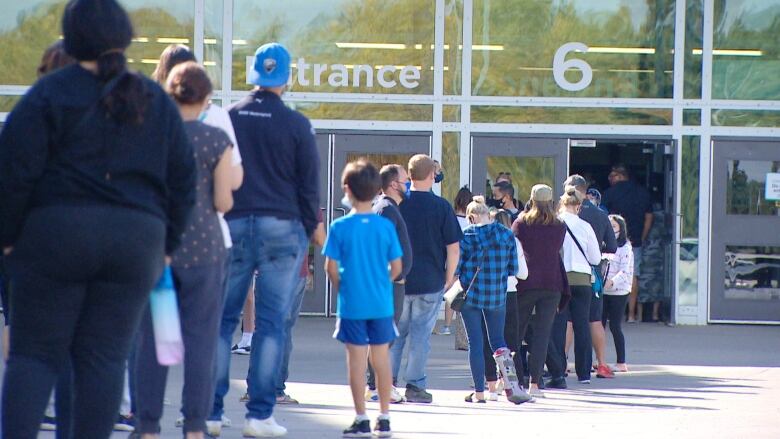May the 4th not be with us: why Manitoba looks better than Prairie neighbours on the cusp of the next wave
Lowest infection rate outside Maritimes, modest bump in vaccinations in place before 4th wave

Since the start of the pandemic, Manitoba has been out of step with muchof Canada.
The first wave of COVID-19, which devastated care homes in Toronto and Montreal, essentially passed right over Winnipeg. The second wave arrived in Manitoba earlier than elsewhere and proved to be deadlier here as well.
The third wave reached Manitoba late,but soon overwhelmed our intensive care wards to an extent so far unseen anywhere else in the country.
Now, with the fourth wave underway in much of Canada, Manitoba is enjoying another quiet moment.
The infection rate within our bordersremainsthe lowest of any province outside the Maritimes. Over the past week, we're averaging threenew cases a day for every 100,000people.
The infection rate is 10.3 times higher next door in Saskatchewan and 9.5 times higherin Alberta, two provinces wheremost pandemic restrictions were eliminatedover the summer.

Manitoba has thus far avoided this fate through what appears to be a combination of good fortune and, as of late, competent pandemic management.
The luck component amounts to timing. The third wave had not entirely receded in Manitoba when the delta variant began fuelling a fourth wave to our immediate west.
That meant some pandemic restrictions remained in place in Manitoba and collective adherence to those restrictions also remained relatively strong, especially when it came to simple actions such as wearing masks in public places.
The provincial government also exercised some prudence in slowly removing what remained of restrictions, notwithstanding the aborted removal of the indoor mask mandate for three weeks in August.
The end result is Manitoba's health-care system is entering the fourth wave of the pandemicwith some capacity to handle yet another influx of COVIDpatients.
"That all bodes well, essentially for potentially where we would be in a few weeks time and when that fourth wave begins and what that fourth wave looks like from a peak perspective or how bad that fourth wave can get," Deputy Provincial Public Health Officer Dr. Jazz Atwal said during a briefing on Tuesday.
"With schools opening up, we know we're going to have a lot more interactions with people. We anticipate obviously there will be more cases just because there's going to be those interactions."
That statement represents a rhetorical shift for Manitoba Public Health, which used to downplay the potential for COVID transmission within schools.
No official can state that credibly any more. As of this week, schools are home to the largest gatherings of unvaccinated people in Manitoba, simply because no oneborn later than 2009 can get a COVIDshot.
Hence the push right now to vaccinate as many people as possible who are in contact with kids under the age of 12. That includesolder students, their parents and people who work in schools, who now have mere weeks to get vaccinated or submit toregularCOVIDtests.
Vaccinationcards create modest bump in doses
After a multitude ofpandemic-management failures during the second and third waves, Manitoba deserves some credit for other vaccination inducements.
Chief among them was the vaccination cards the province unveiled in June as pre-requisites for entry to restaurants, movie theatres, sporting events and other places where strangers breathe the same air.
While most of these requirements were lifted for a time in August, their return on Sept. 3 has led to a modest but measurable increase in vaccinations.
Manitoba's vaccine administration bottomed out on Aug. 23at a rolling average of 2,659 shots a day. Four days later,the chief provincial public health officer announced the expansion of vaccination-card requirements.
Vaccine administration shot up to a rolling average of 3,295 doses a day by Sept. 3, when the new restrictions kicked in.
"The vaccine appointments hadbeen going down week over week for quite a while, so what we've been seeing since that announcement is that they're not going down any more," vaccine team medical lead Dr. Joss Reimer said during the Tuesday briefing.
"Wedon't see any massive increases in the appointments on an ongoing basis, but we are seeing a steady number of people making appointments."
Roughly half of the doses doled out in Manitoba over the past weekhave been first doses. This can be seen as a policy success, given the overall goal is to get shots into the arms of as many people as possible in order to blunt the severity of the fourth wave, when it finally arrives.
As of Wednesday, nearly one million Manitobans had at least one shot. About 192,000 eligible adults have chosen not to get any shots, while another 193,000 are too young to be eligible.
Most of the people catching COVIDnow roughly 70 per cent have no shots at all. The vast majority of thepatients in intensive careare also unvaccinated against the virus.
In other words, the fraction of Manitobans unwilling or unable to get vaccinated are experiencing the majority of the pandemic's ill effects right now.
It remains to be seen whether the volume of those ill effects will rival what we now see in Saskatchewan and Alberta.












_(720p).jpg)


 OFFICIAL HD MUSIC VIDEO.jpg)
.jpg)



























































































